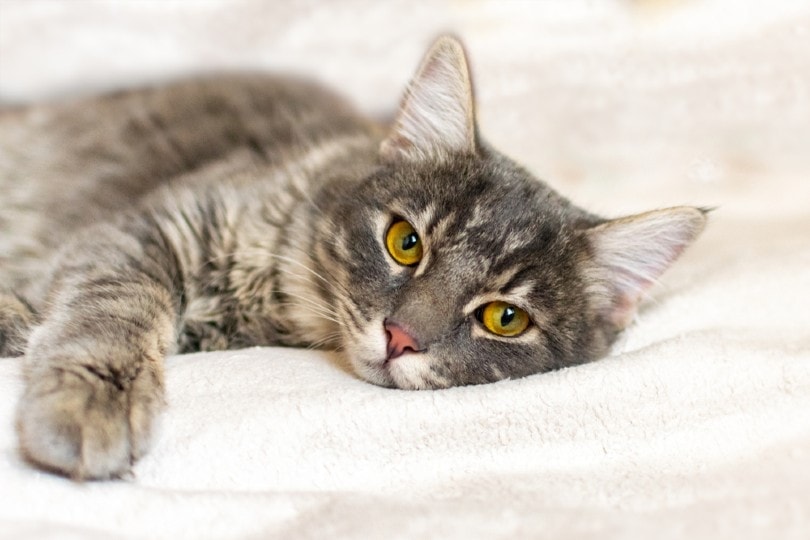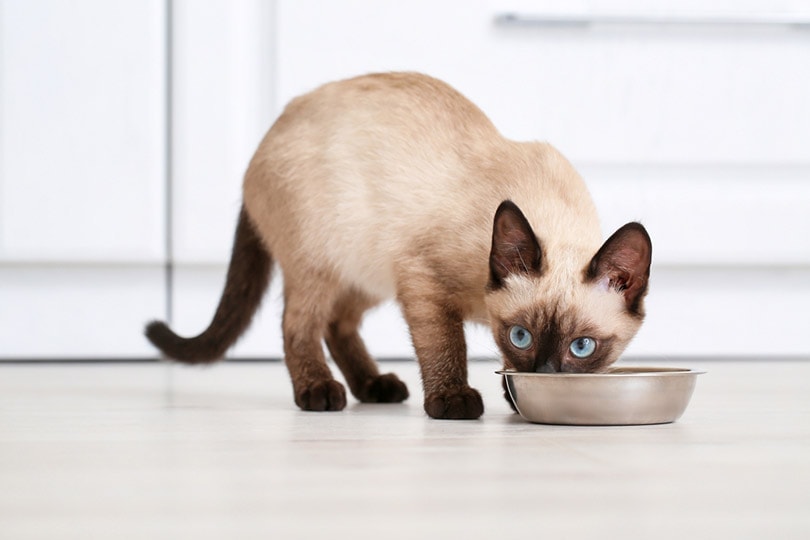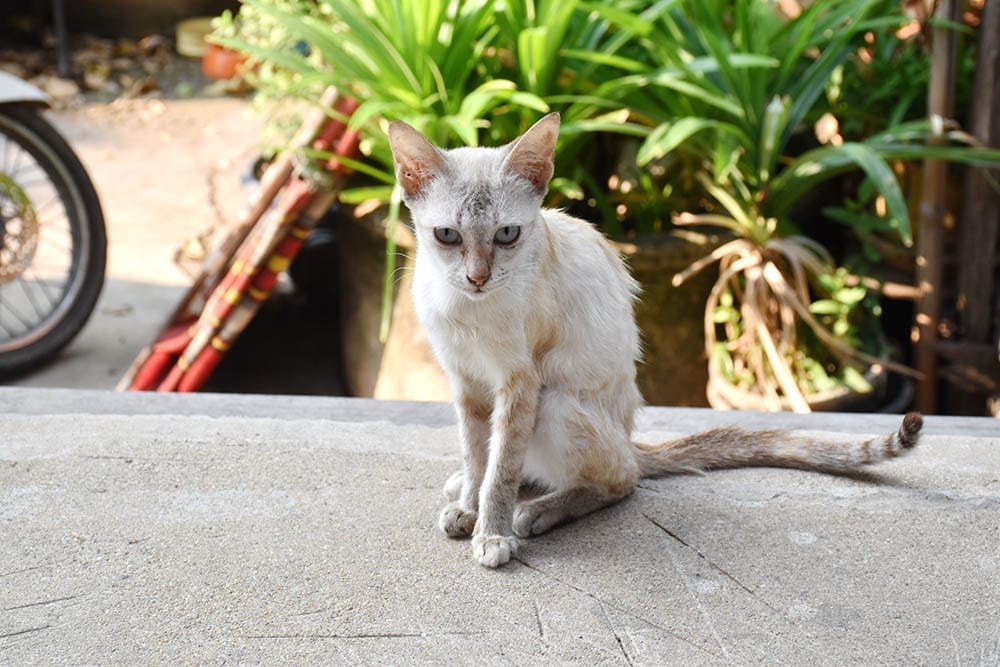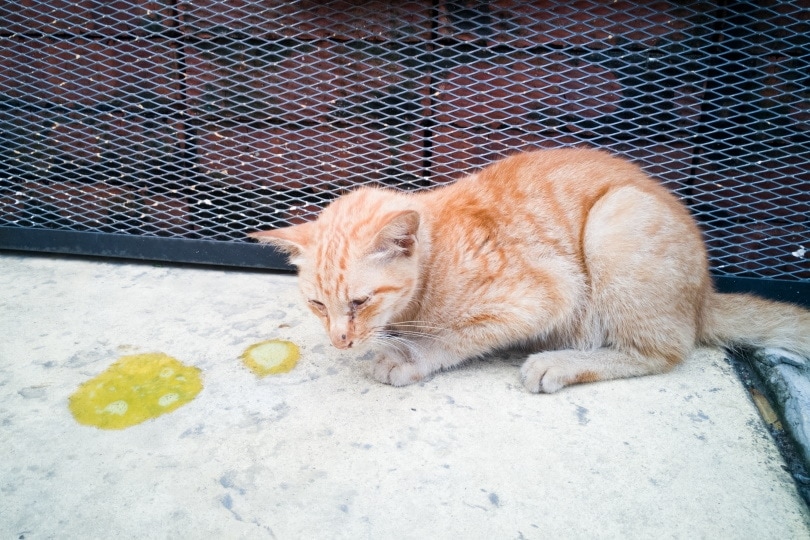How To Tell If Your Cat Has Diabetes: Our Vet Explains

Updated on

Click to Skip Ahead
Diabetes mellitus, which is commonly referred to as diabetes, is one of the most common endocrine disorders of domestic cats. According to Cornell University College of Veterinary Medicine, it is estimated that between 0.2% and 1% of cats will be diagnosed with diabetes during their lifetime. We’ll break down how you can spot the signs of this illness and what you should do as a responsible pet parent to help your feline live their best lives with diabetes.
The Basics of Diabetes
Diabetes occurs when the body cannot produce enough insulin or when the body doesn’t respond to insulin appropriately. This leads to raised glucose levels in the blood. The medical term for high blood sugar is hyperglycemia.
Insulin is a hormone that is produced by cells in the pancreas called beta cells. Insulin plays a number of roles in the body’s metabolism. Its main role is to regulate blood glucose levels. Glucose is a type of sugar that is produced by the breakdown of carbohydrates. It is the main energy source of cells in the body.
After a cat eats a meal, its blood glucose levels rise and insulin is released by the pancreas. Insulin helps glucose enter the cells of the body where it is used as energy, and helps maintain normal blood glucose levels. Extra glucose not used as energy is converted and stored as fat, which can be used as energy when glucose levels are low. Cats with diabetes are unable to efficiently use glucose as a source of energy even though blood glucose levels are high.

What Are The Most Common Symptoms Of Diabetes?
The four most common symptoms of diabetes in cats are:
1. Increased Urination (Polyuria)
Normally, when the kidneys filter blood to produce urine, they reabsorb glucose, returning it to the bloodstream. However, if blood glucose levels are abnormally high, the kidneys’ ability to filter glucose is overwhelmed, resulting in glucose spilling over into the urine. The high urine glucose concentration draws more water into the urine. This results in unusually large volumes of urine and increased urination. Cats with diabetes are at an increased risk of becoming dehydrated.
2. Increased Thirst (Polydipsia):
In order to compensate for the water that is lost through increased urine production, a cat will drink more water.
3. Weight Loss
Weight loss occurs as diabetic cats are unable to use blood glucose as energy. As a result, the body becomes starved of energy and starts to break down fat and muscle in order to meet its energy requirements. The breakdown of fat and protein causes a reduction in the overall body weight of a diabetic cat.
4. Increased Appetite (Polyphagia)
In diabetes, the body cannot convert glucose into energy. This lack of energy causes an increase in hunger which doesn’t go away after consuming food.
The severity of these symptoms will vary between individual cats.

Additional Symptoms of Diabetes in Cats
Other symptoms that may be seen in cats with diabetes include:
Plantigrade Stance
Diabetic cats may develop damage to the nerves in the hindlimbs as a result of prolonged high blood glucose levels. As a result, affected cats will walk and stand with their heels on or close to the ground. This is known as a plantigrade stance. If the condition is treated in the early stages by regulating blood sugar levels, the damage is often reversible.
Urinary Tract Infections (UTIs)
Cats with diabetes are predisposed to develop urinary tract infections and may show signs associated with UTIs such as straining to urinate, frequent trips to the litter box, and blood in the urine.
Decreased Appetite, Vomiting, Lethargy, Dehydration, and Collapse
These symptoms may be a sign of diabetic ketoacidosis. Diabetic ketoacidosis is a dangerous and life-threatening complication of diabetes that goes untreated. This condition occurs when the body produces high levels of blood acids called ketones from the breakdown of fat.
- Related Read: How To Tell If Your Cat Is Having a Seizure (Vet Answer)

What Are The Risk Factors For Diabetes?
The following risk factors increase the chance that a cat will develop diabetes:
Obesity: Obesity causes an impaired tissue response to insulin (insulin resistance) which is a critical component of diabetes. Obesity increases the risk of developing diabetes three to five-fold.
Physical Inactivity: Along with obesity, physical activity also causes insulin resistance.
Gender: Male cats are 1.5 times more likely to develop diabetes than female cats.
Increasing Age: Diabetes is mainly diagnosed in middle-aged cats to older cats. The average age at diagnosis for feline diabetes is 10 years old.
Neutering: Neutered cats have nearly twice the risk of developing diabetes.
The Use of Glucocorticoids: Glucocorticoids are steroid hormones with potent anti-inflammatory effects. They are used to treat illnesses such as feline asthma and irritable bowel disease (IBD). Diabetes may develop as a consequence of the administration of glucocorticoids.
What Are The Different Types of Diabetes?
Diabetes is classified as Type I or Type II. In Type I diabetes, blood glucose levels are high because the pancreas does not produce enough insulin, while in Type II diabetes, blood glucose levels are high because cells are unable to respond appropriately to insulin.
As a result, in both Type I and Type II diabetes, the cells of the body are unable to efficiently use glucose as a source of energy even though blood glucose levels are high. Cats most commonly suffer from Type II diabetes.
How Is Diabetes Diagnosed?
The clinical signs are suggestive of diabetes, as well as persistently high glucose levels in a cat’s blood and urine.
Although the presence of high levels of glucose in the blood (hyperglycemia), as well as glucose in the urine (glucosuria), are typical findings in diabetes, they can also be caused by stress. Cats often experience stress when visiting the vet clinic. Diabetes can therefore not be diagnosed on a single blood glucose reading alone. In order to confirm a diagnosis of diabetes, blood will often be sent to the lab for a fructosamine test.
Fructosamine gives an average of a cat’s blood glucose concentration over the previous 2-3 weeks and is not affected by stress hyperglycemia. This test is useful in both diagnosing and monitoring diabetes.
How Is Diabetes Treated?
Diabetes is treated through a combination of injectable insulin and a low carbohydrate diet. Insulin injections are given under the skin every 12 hours after a meal.
What Is The Prognosis For A Cat Diagnosed With Diabetes?
While there is no cure for diabetes, cats with diabetes can live happy, normal lives if they are given regular insulin injections, and are fed the correct diet to keep their weight down and their blood glucose levels stable. Managing feline diabetes requires lifelong, daily commitment. If feline diabetes is not treated, it can be life-threatening.
With early treatment, some cats enter a state of diabetic remission. This means that they are able to maintain normal blood glucose levels without insulin injections. Cats in diabetic remission will need to remain on a special diet and have their blood glucose levels regularly monitored.
Conclusion
If you suspect that your cat has diabetes, visit your veterinarian as soon as possible. Excessive urination, thirst, increased appetite, and weight loss are the most common symptoms of diabetes mellitus. A plantigrade stance, recurrent urinary tract infections, and symptoms of diabetic ketoacidosis (decreased appetite, vomiting, lethargy, dehydration, and collapse) may also indicate that your cat is suffering from diabetes.
Featured Image Credit: Ro_ksy, Shutterstock















